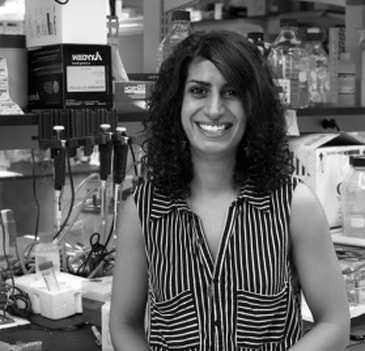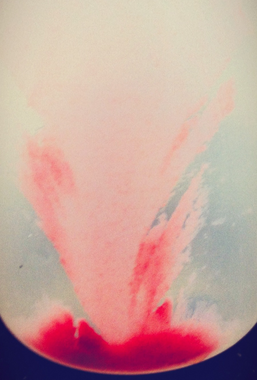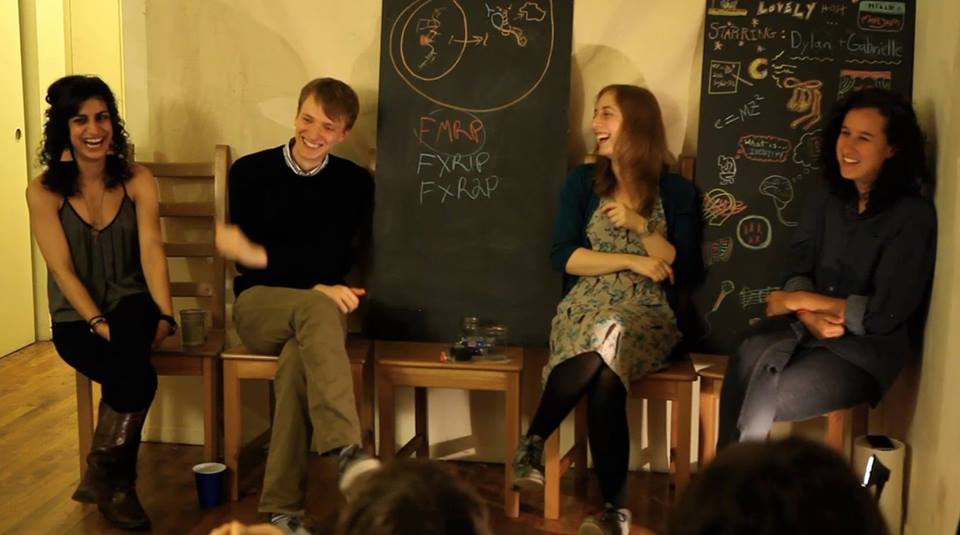Maryam Zaringhalam
Scientist
Interview by Julia Buntaine, SciArt Director
Scientist
Interview by Julia Buntaine, SciArt Director

JB: As a scientist, what is your focus of research?
MZ: I have a serious thing for blueprints and patterns. As a kid I would constantly break things apart - like my brother’s LEGO sets and my parents’ telephones - and attempt to reverse engineer them back together again, completely obsessed with how the parts fit together to make the whole. And that’s still largely what I do now, except that I get to tell people I’m a molecular biologist instead of the family’s resident troublemaker.
My molecule of choice is RNA - DNA’s less famous, but arguably far more intriguing cousin. While DNA is rather vainly sitting in the nucleus replicating itself, the RNA is shuttling the information encoded in the DNA out to the rest of the cell. Along the way, a whole slew of things can happen to these RNA molecules: they can be targeted for destruction; they can be chopped up and spliced back together again; they can be chemically and irreversibly modified. So RNA is this incredibly dynamic and diverse intermediary molecule, which ends up being really great inspiration for a compulsive pattern-finder like me to actually try to find some patterns.
MZ: I have a serious thing for blueprints and patterns. As a kid I would constantly break things apart - like my brother’s LEGO sets and my parents’ telephones - and attempt to reverse engineer them back together again, completely obsessed with how the parts fit together to make the whole. And that’s still largely what I do now, except that I get to tell people I’m a molecular biologist instead of the family’s resident troublemaker.
My molecule of choice is RNA - DNA’s less famous, but arguably far more intriguing cousin. While DNA is rather vainly sitting in the nucleus replicating itself, the RNA is shuttling the information encoded in the DNA out to the rest of the cell. Along the way, a whole slew of things can happen to these RNA molecules: they can be targeted for destruction; they can be chopped up and spliced back together again; they can be chemically and irreversibly modified. So RNA is this incredibly dynamic and diverse intermediary molecule, which ends up being really great inspiration for a compulsive pattern-finder like me to actually try to find some patterns.
 Yeast RNA
Yeast RNA
To be more specific, I’m interested in a modification called “pseudouridylation,” which happens all over the place in RNA, but no one really has a clear sense of its functional role, other than that it’s super important. So I’ve been developing a technique to extract and mine through all of the cell’s RNA to find patterns of pseudouridylation with the idea that those patterns can help give us some insight into what it’s doing and why it’s crucial for cellular function.
JB: You also run a fantastic science-art related blog called ArtLab - can you tell us a bit about what ArtLab is, and why you started it?
MZ: One of the great things about keeping a blog is that you have this immortalized record of your thoughts. So to quote the 2012 version of myself, “I have started this blog as a dare to myself to step outside the Ivory Tower and actually venture to talk about what it is we do up here using the language of art.” And 2014 me couldn’t agree more.
Since college, I’ve found myself gravitating towards the artistically inclined because I really just love the way they talk about their work - with a sense of passion and curiosity and open-endedness. It’s totally the way I think and feel about science, but I never had much of an outlet to share that personal, awe-struck side with my peers. So having the space to talk about my scientific interests to friends outside my academic bubble was hugely liberating for me. The more I talked about my scientific interests, the more I found myself channeling so much of what I loved about artists-speak, and the more I found I had in common with my artist friends in terms of the big questions we were constantly asking. It was a way of zooming out and finally seeing my work in a context that actually meant something than a hodgepodge of jargony words and sentences.
So ArtLab is really a space for me to continue that exploration of science through the lens of art, which has paved the way for some really incredible conversations with people all over the science-art spectrum. Shortly after I started the blog, I launched ArtLab: The Series, which has now grown out of my friends’ living room and into Brooklyn venues. The idea is to pair artists and scientists in conversation about their work in live space to see how each deepens and enriches an appreciation of the other. Finding my way to this art-science space, I have this perspective now that I never would have had if I just stayed stuck within the confines of my own disciplinary lines, which has kept me grounded - and ultimately sane!
JB: You also run a fantastic science-art related blog called ArtLab - can you tell us a bit about what ArtLab is, and why you started it?
MZ: One of the great things about keeping a blog is that you have this immortalized record of your thoughts. So to quote the 2012 version of myself, “I have started this blog as a dare to myself to step outside the Ivory Tower and actually venture to talk about what it is we do up here using the language of art.” And 2014 me couldn’t agree more.
Since college, I’ve found myself gravitating towards the artistically inclined because I really just love the way they talk about their work - with a sense of passion and curiosity and open-endedness. It’s totally the way I think and feel about science, but I never had much of an outlet to share that personal, awe-struck side with my peers. So having the space to talk about my scientific interests to friends outside my academic bubble was hugely liberating for me. The more I talked about my scientific interests, the more I found myself channeling so much of what I loved about artists-speak, and the more I found I had in common with my artist friends in terms of the big questions we were constantly asking. It was a way of zooming out and finally seeing my work in a context that actually meant something than a hodgepodge of jargony words and sentences.
So ArtLab is really a space for me to continue that exploration of science through the lens of art, which has paved the way for some really incredible conversations with people all over the science-art spectrum. Shortly after I started the blog, I launched ArtLab: The Series, which has now grown out of my friends’ living room and into Brooklyn venues. The idea is to pair artists and scientists in conversation about their work in live space to see how each deepens and enriches an appreciation of the other. Finding my way to this art-science space, I have this perspective now that I never would have had if I just stayed stuck within the confines of my own disciplinary lines, which has kept me grounded - and ultimately sane!
JB: What would you like to see in the evolving relationship between science and art, what do you think the future of sciart holds?
MZ: As a scientist, much of my interest in the science-art world comes from how we can open up a meaningful conversation about science through the lens of art. And I’m not talking about art in service of the science, because while I think that is certainly a helpful tool for communicating science, I also feel it can limit creativity on both sides. Artists are real masters of the senses: they know how to craft compelling narratives, appeal to our visual sensibilities, strike a chord with our ears, make us feel intuitively and viscerally. And those are all extremely important tools not only for conveying how incredibly awesome science is, but also
In my experience, raw data is neither immediately intuitive nor terribly evocative. Rather, the power of data comes from its presentation. So as a raw data miner, I’m hugely excited by the opportunity for scientists and artists to work together to sort out the massive amounts of data that scientists are rapidly churning out--whether that’s through visualization, sonification, performance, or some other new medium yet to be discovered and explored. And to do this not just in some didactic, this-is-what-this-all-means kind of way, because that’s boring, and not really the way science works anyway. But to grapple with data in a way that highlights not only compelling points of clarity, but also exciting areas of ambiguity that open up new avenues of investigation.
Ultimately, I feel where scientists and artists have the most common ground is in our incessant curiosity and drive towards exploration using the tools of our respective trades. So if we could work to bring those strengths together to push those boundaries of inquiry even further, then holy smokes! That would be amazing.
Maryam Zaringhalam lives and works in New York, and is a PhD student at Rockefeller University. Visit ArtLab's website here, and contact Maryam at: [email protected].
MZ: As a scientist, much of my interest in the science-art world comes from how we can open up a meaningful conversation about science through the lens of art. And I’m not talking about art in service of the science, because while I think that is certainly a helpful tool for communicating science, I also feel it can limit creativity on both sides. Artists are real masters of the senses: they know how to craft compelling narratives, appeal to our visual sensibilities, strike a chord with our ears, make us feel intuitively and viscerally. And those are all extremely important tools not only for conveying how incredibly awesome science is, but also
In my experience, raw data is neither immediately intuitive nor terribly evocative. Rather, the power of data comes from its presentation. So as a raw data miner, I’m hugely excited by the opportunity for scientists and artists to work together to sort out the massive amounts of data that scientists are rapidly churning out--whether that’s through visualization, sonification, performance, or some other new medium yet to be discovered and explored. And to do this not just in some didactic, this-is-what-this-all-means kind of way, because that’s boring, and not really the way science works anyway. But to grapple with data in a way that highlights not only compelling points of clarity, but also exciting areas of ambiguity that open up new avenues of investigation.
Ultimately, I feel where scientists and artists have the most common ground is in our incessant curiosity and drive towards exploration using the tools of our respective trades. So if we could work to bring those strengths together to push those boundaries of inquiry even further, then holy smokes! That would be amazing.
Maryam Zaringhalam lives and works in New York, and is a PhD student at Rockefeller University. Visit ArtLab's website here, and contact Maryam at: [email protected].


